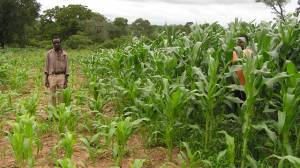- Conserving dambos for livelihoods in southern Africa. How many CWRs are found in such wetland habitats around the world, I wonder.
- Cucumis not out of Africa.
- Exploring “the connection between traditional knowledge of herbs, edible and medicinal plants and media networked culture.” And why not.
- PBS video on malnutrition.
- Fungal exhibition at RBG Edinburgh.
- Indian Council on Agricultural Research framing guidelines for private-public partnerships in seed sector. That’ll stop the GM seed pirates.
- Conserve African humpless cattle! They’re needed for breeding.
- UG99 — and crop wild relatives — in the news. The proper news. The one people pay attention to.
- Vanilla lovers better start stocking up.
- Kenyan farmers earning money selling sorghum to brewers. What’s not to like.
Russia to preserve more biodiversity (Joke Edition)
A recent press release from WWF notes that Russia is gazetting “9 new nature reserves and 13 national parks covering a total area of over 3.8 million ha by 2020”. That’s an area almost the size of Switzerland and almost 3 per cent of Russia’s total area.
Bravo.
But they won’t protect 10 hectares of irreplaceable genebank near St Petersburg?
GMAFB!
Conserving crop wild relatives in situ is hard
Our friends at Bioversity International have a nice piece on IUCN’s website summarizing their work on in situ conservation of crop wild relatives with over 60 partners in five countries around the world. I liked the general tone of understatement: “What became obvious from the project’s outset was that the in situ conservation of CWR is not an easy task and cannot be achieved alone.” The practical lessons of the project have been brought together in a manual.
The piece also includes a trenchant quote from a recent IUCN publication: 1
In general, the idea that the conservation of agrobiodiversity is a potentially valuable function of a protected area is as yet little recognised. For example, it would appear from the case studies that it hardly ever appears explicitly in protected area legislation, and rarely in management plans. Indeed, a study by WWF found that the degree of protection in places with the highest levels of crop genetic diversity is significantly lower than the global average; and even where protected areas did overlap with areas important for crop genetic diversity (i.e. landraces and crop wild relatives), little attention was given to these values in the management of the area (Stolton et al 2006).
Nibbles: Danone, Street food, Makutano Junction, Canberra, Africa, Markets, Veggies
- Let them eat yoghurt. Danone targets the poor. h/t Tom
- Eating Mexico City, one street at a time. Bookmarked.
- It’s The Archers, Jim, but not as we know it. Soaps spread (agro)innovation.
- The Crawford Fund Conference does biodiversity (in Australia)
- New Agriculturist reports on a discussion of development in Africa. Is anybody listening?
- Food markets freed! A little. In one US state.
- Local leafy greens all the rage in Kenya. Yeah, yeah. No but seriously, one of the great changes in the past 10 years, and a major agrobiodiversity success story.
Livestock reverse desertification
There’s something delicious about received wisdom being overturned. For example, you’ll hear it said, categorically, that livestock turn fragile landscapes into desert; they eat the plants binding the soil, and their hooves cut up the surface and promote erosion. But it ain’t necessarily so.
Operation Hope, a Zimbabwean NGO and winners of $100,000 Grand Prize in the Buckminster Fuller Challenge, has
[T]ransformed 6,500 acres of of parched and degraded grasslands in Zimbabwe into lush pastures replete with ponds and flowing streams – even during periods of drought.
The quote is from a write-up in Seed magazine, which gives lots of details of the story. In essence, the key to livestock and grasslands is time, not numbers. If animals are on the land too long, their hooves do indeed powder the soil and they do overgraze. But if they are free to move on, or are moved by herders, moderate trampling allows rain to percolate into the soil, rather than run off and cause erosion. It also improves contact between seeds and soil, promoting germination. And dung and urine return plant matter to the soil to increase fertility and sequester more carbon, without becoming pollutants.
Operation Hope grazes animals in one spot for a maximum of three days, and they do not return for at least nine months, mimicking the natural movements of large herbivores on the savannah. At night they are protected from predators in portable kraals, which are also mobile to prevent a build-up of dung and urine. The effects are impressive. (“Animal-treated” field on the right, conventionally managed field on the left. Image courtesy Buckminster Fuller Institute”)

What’s interesting, and this is explored in much more detail in the Seed article, is that this kind of ecosystem thinking, which requires human knowledge and ingenuity to tackle complex problems, could have applications well beyond range management. Allan Savory, the scientist behind Operation Hope and the Africa Centre for Holistic Management, is hard on the Green Revolution.
“We posit the necessity of a new ‘Brown Revolution’, based on the regeneration of covered, organically rich, biologically thriving soil, and brought to fruition via millions of human beings returning to the land and the production of food.”
Of course, that’s hard work. But it is also surely much more interesting and fulfilling.